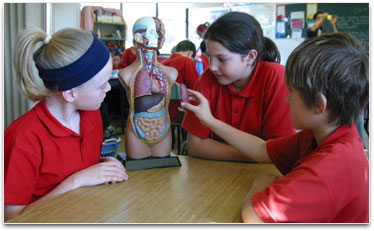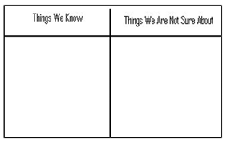This focus idea is explored through:
Contrasting student and scientific views
Student everyday experiences
 Students often have difficulty understanding that the human body relies on systems which work independently and together such as the circulatory, respiratory, nervous and digestive systems. It is common for students to acknowledge the qualities of the separate organs rather than seeing the interactions between the parts of a system. They tend to think each organ has its own independent function - the eyes are for seeing, the brain is for thinking, the stomach is for digesting food.
Students often have difficulty understanding that the human body relies on systems which work independently and together such as the circulatory, respiratory, nervous and digestive systems. It is common for students to acknowledge the qualities of the separate organs rather than seeing the interactions between the parts of a system. They tend to think each organ has its own independent function - the eyes are for seeing, the brain is for thinking, the stomach is for digesting food.
For some younger students their knowledge of the internal structure of the human body may be very simple; some imagine their bodies as hollow skin bags and believe that swallowed food floats around in any area of the body. These ideas may change for older primary school students who begin to recognise the body has essential requirements and that the food they eat and the oxygen in the air they breathe must get around their bodies somehow, although many are unsure how this happens.
Research: Fleer and Hardy (1996)
Scientific view
When two or more organs along with their associated structures work together they become component parts of a body system. Working together, systems inform and maintain the human body. Each system has an essential role and if one system fails the others are affected, either directly or indirectly . Some of these systems include: the circulatory system, the skeletal system, the muscular system, the respiratory system and the nervous system.
The digestive system is a series of connected organs from mouth to anus whose purpose is to break down, digest and excrete wastes from the food we eat. The digestive system breaks down complex food molecules into simple molecules, many of which are used by our bodies, so that these useful simple molecules can be absorbed easily into the bloodstream. These molecules travel in the blood to all of the body's cells, where they are used for growth, repair and energy. Those molecules that are not useful are excreted.
Critical teaching ideas
- The human body is very complex and relies on a variety of body systems for obtaining and deriving energy from food, defence against biological attack and mechanical injury, reproduction and the coordination of body functions.
- These body systems must work together; if one system fails other systems are affected. For example, a failure in the digestion system such as inability to absorb water results in difficulties for the circulatory system in the consistency of the blood.
- Each body system has a particular function.
- Each body system consists of many parts comprising organs, tissues and cells which all work together and influence one another. For example, the mouth, gut (which includes stomach and intestines) and anus are all organs which work together in different ways to absorb nutrients and expel wastes from the tissues and cells of the body.
- All parts of a particular system must work together to carry out their vital function.
- Models and simulations provide useful visual representations, which can be used to assist understanding of the various changes and processes that take place in the digestive system.
 Explore the relationships between ideas about body systems and organs in the
Concept Development Maps – Cell Functions
Explore the relationships between ideas about body systems and organs in the
Concept Development Maps – Cell Functions
Exploring the human body systems is challenging because of the dynamic, complicated and often molecular nature of the processes within the human body. A further challenge is faced when attempting to relate the different systems in the body to the functioning of the body as a whole. It is important that the learning experiences provided work towards aiding an understanding that parts within a system usually influence one another and that a system may not work as well, or at all, if a part is missing, broken, worn out or misconnected.
In working towards this understanding it may be more useful to focus on one system in detail, exploring how component parts work together to carry out the vital functions. This may act as a model for further investigations into other systems. It is also important to highlight how this one system works with and relies on other systems in the human body.
Teaching activities
Bring out students’ existing ideas
Provide an experience that invites students to explore their own understanding of what happens to food as it moves through the human body. For example, students bite a sample of food and observe any changes in the food sample, such as teeth imprints. They explore the mechanics of how the piece of food was broken off. Encourage students to discuss the importance of their teeth and tongue for eating.
Focus students’ attention to specific details
Use questions to explore observed changes such as the change in texture of the food item by the time it was swallowed. For example, ask, ‘Why is it important that food is broken into smaller pieces as it moves through the body?’ ‘How is this done in different parts of the digestive system?’ ‘Where did this piece of food go?’ Explore and list ideas - use a body outline to map the movement of this food through the body. Students share their ideas about the body parts the food will move through and the changes that will occur as the food moves through the body.
Share intellectual control
 Provide an opportunity for students to consider their own ideas and track changes in their thinking and learning. Create a class thinking board with suitable headings such as ‘Things we know’ and ‘Things we are not sure about’. Use this to guide further investigation of the digestive system. Return to this each session and encourage students to add new information or move items from one side of the board to the other as their thinking changes.
Provide an opportunity for students to consider their own ideas and track changes in their thinking and learning. Create a class thinking board with suitable headings such as ‘Things we know’ and ‘Things we are not sure about’. Use this to guide further investigation of the digestive system. Return to this each session and encourage students to add new information or move items from one side of the board to the other as their thinking changes.
Help students work out some of the scientific explanations for themselves
Provide models and simulations to investigate the various changes and processes that take place in the digestive system. These could include using a variety of materials including large boxes, balloons and zip lock bags to create a life size model containing all the various parts of the digestive system. Some examples include using simple chemical and physical reactions to explore the role of the stomach’s digestive juices in the breakdown of food, using filters to explore what occurs in the intestines and using coloured streamers to create a model of the actual overall length of the various parts of the digestive system from mouth to anus. Work with students to design a role-play activity that demonstrates what happens to food particles as they move through the digestive system.
Provide an opportunity for students to clarify and consolidate their ideas
Provide students with the opportunity to make explicit connections between knowledge gained through previous activities and their developing understanding of the overall functioning of various parts of the digestive system. Use an ‘if…then’ strategy to explore the interdependency of the various parts of the digestive system. For example: If we had no teeth then…. If we could not break down food then…. If the walls of the intestines allowed all digested materials to enter the blood then…
Further resources
Science related interactive learning objects can be found on the
FUSE Teacher Resources page.
To access the interactive learning object below, teachers must login to FUSE and search by Learning Resource ID:
-
Body Parts: digestive system – students take a journey through the human digestive system. They find out how food is moved around, broken down and absorbed, and wastes excreted. They learn what enzymes are and which organs release them.
Learning Resource ID: GU5A7N